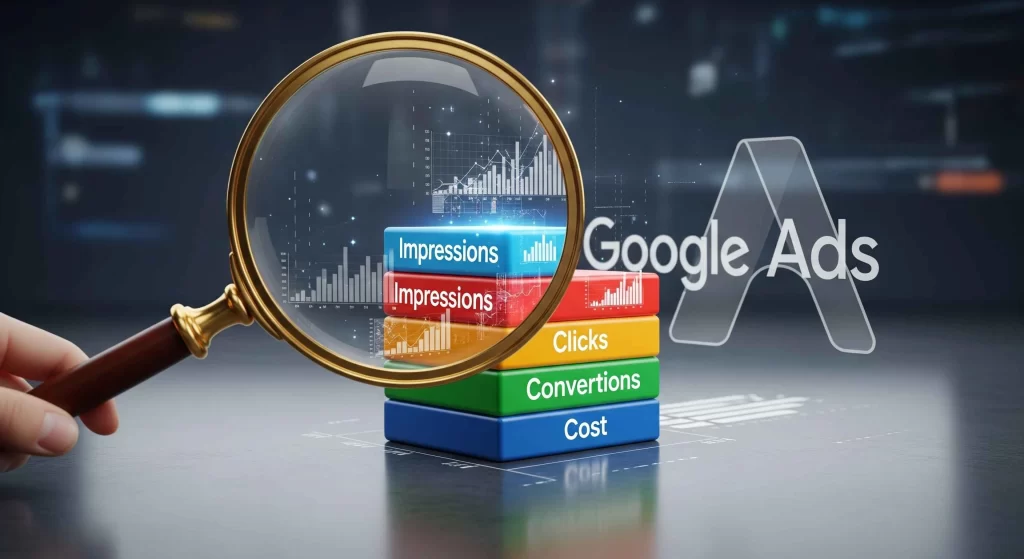Once upon a time, your competitors could peek into your ads( your headlines, visuals, offers), while you see nothing of theirs. Today, things have changed. With the Google Ads Transparency Center (also called Ads Transparency, Google Ads Library, Ads Transparency Tool), that one‑sided advantage flipped.
If you’re not actively using the Transparency Center to study competitor ads, you’re already behind.
This tool gives you access to what ads others are running on Google Search, YouTube, Display, Gmail, Discover. You get to see what works, so you don’t waste time reinventing the wheel.
This post is for complete beginners and marketers alike: simple, step‑by‑step, and focused on what matters.
Here’s the roadmap:
- What is Google Ads Transparency Center
- Why that matters (benefits for advertisers & users)
- Meta ads transparency, Facebook Ads transparency, Meta ads library — comparisons
- How to use the transparency center
- Real examples and FAQs
So, let’s get started!
What Is Google Ads Transparency Center?
Google Ads Transparency Center is a public, searchable ad library for Google. It shows ads that verified advertisers are running or have run in past months across Google Search, YouTube, Display, and Gmail.
You can look up by advertiser name or URL and filter by region, ad format (video, text, image), and date range.
For example, if we search Myntra on this tool, ads they are currently running will show up on this tool.
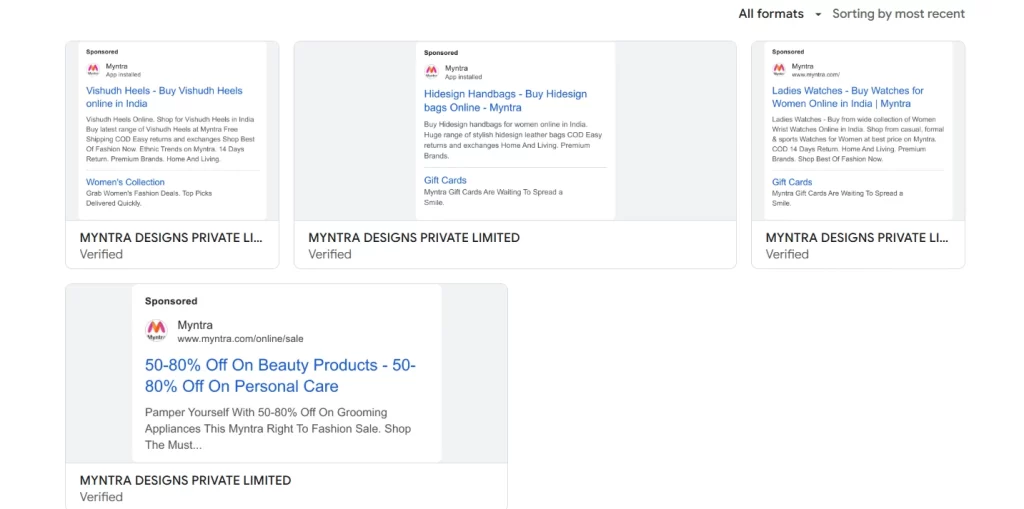
Launched in March 2023 and gradually available worldwide, it’s part of Google’s push for ad transparency, user trust, and advertiser accountability.
You can also access it by clicking the three‑dot menu next to any Google ad(Sponsored will written on the top of it),
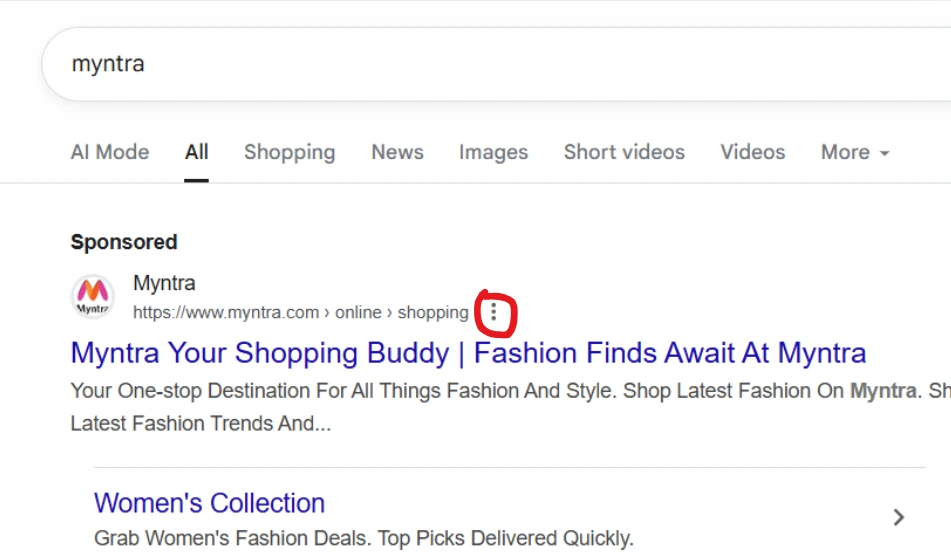
Then (“About this ad”), and clicking the link to the center.
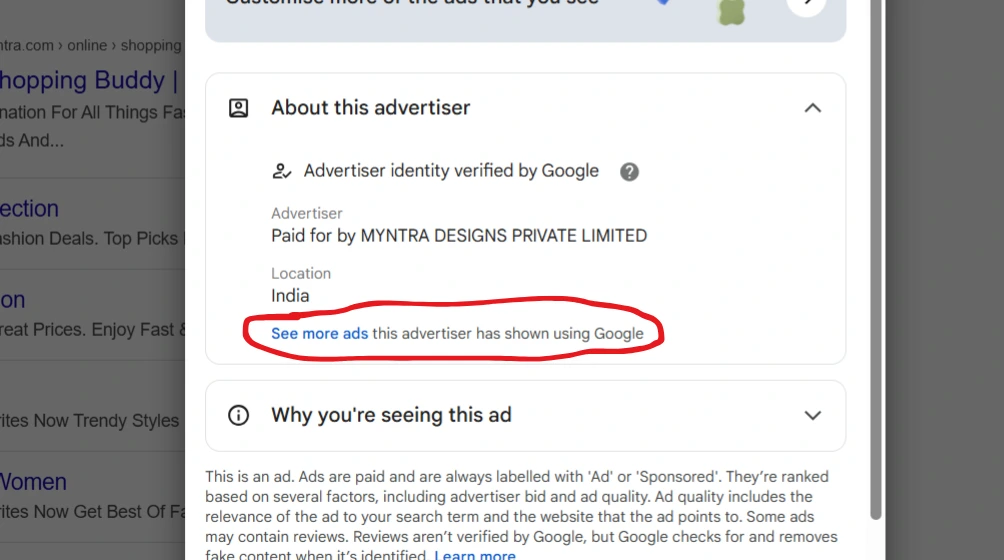
Benefits: Why Transparency Gives You an Edge
For Advertisers (That Means You)
- Spy on competitor ads: See your competitors’ active and recent ads, formats, messaging, CTAs, visuals, landing pages.
- Discover new keywords and offers: If they bid on certain keywords or offers, it likely works. If they dropped others, maybe avoid them.
- Optimize your messaging and format: You see what works for them and adapt for yourself, ad headlines, description, angles etc.
- Save time and money: Avoid testing countless ideas blind. Learn what lands and what flops fast.
For Consumers / Everyday Users
- Know who’s sponsoring ads: For example, political ads must disclose advertiser identity, who is paying, which election. Helps build trust.
- See other ads run by an advertiser: Explore more before you buy or trust.
- Feedback options: Like, block, or report ads you find annoying or misleading.
Comparing Ad Transparency in Other Platforms
Now let’s see how Google’s library stacks up next to other platforms:
Meta Ads Transparency / Facebook Ads transparency
Facebook and Meta have their own Ads Library. It includes political and issue‑based ads older than 7 years, and gives metadata like spend estimates. But Meta’s library covers only Meta platforms (Facebook, Instagram), not Google Search or YouTube.
Meta is often criticized for broad definitions and including issue ads, while Google tends to limit political ads to ads that mention politicians or elections explicitly
Google Ads library vs. Meta
| Feature | Google Ads Transparency Center | Meta Ads Transparency / Meta Ads Library |
| Platforms covered | Google Search, YouTube, Display, Gmail, Discover | Facebook, Instagram |
| Political / issue ads | Only explicit political ads (declared) | Broader issue-based ads |
| Verified advertiser info | Shows identity, formats, regions, start dates | Similar information plus spend estimates |
| Audience control | Users can block/report ads from My Ad Center | Limited to reporting |
So, ‘Google ads transparency center how to use’ is important to know because it’s not just another tool, it gives you access to Google’s ad ecosystem, which is far larger in many consumer contexts.
How to Use Google Ads Transparency Center (Step-by-Step)
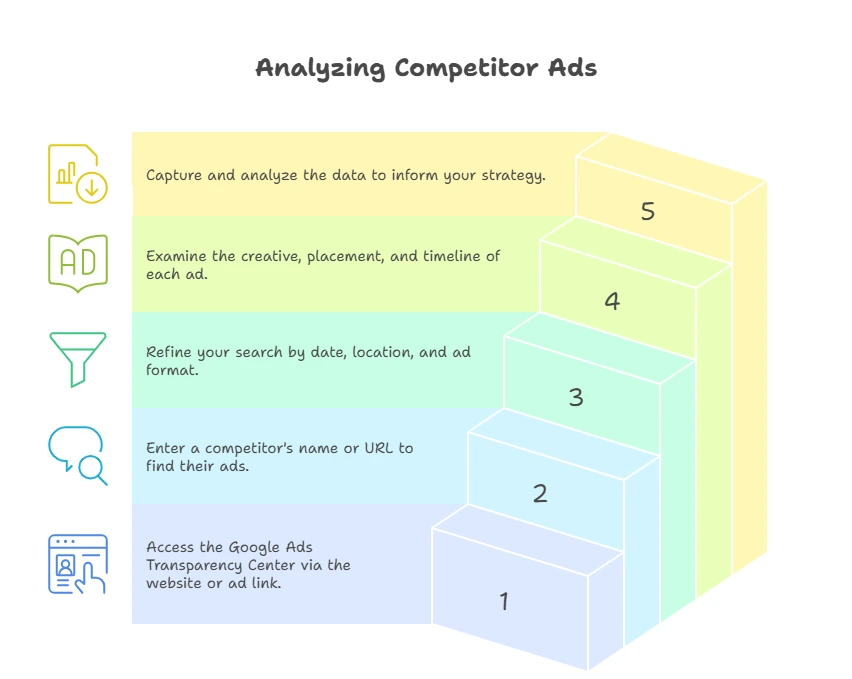
Here’s how to use Google ads transparency center to spy on your competitors or learn. Even total beginners can follow this:
Step 1: Visit the tool
- Go to adstransparency.google.com, or click “About this ad” from any Google ad on Search, YouTube, etc.
Step 2: Search an advertiser
- Enter a competitor’s name or website URL. The tool will pull up active and recent ads for that advertiser. This includes search ads, YouTube ads, display banners, Gmail ads, etc.
Step 3: Apply filters
- Filter by:
- Date range (last week, month, up to several years ago)
- Location / region (e.g. India, US, UK)
- Ad format (text/search, video/YouTube, image/display)
This lets you zone in on ads most relevant to your market and campaign type.
Step 4: Explore each ad’s details
For each ad you see, you can view:
- Creative: headline, description, images, video snippet
- Where shown: Search, YouTube, Display
- Start date / timeline
- Advertiser identity and verification status
Step 5: Download insights, take notes
- You can take screenshots or notes:
- Which headlines or CTAs repeat?
- What offers or discounts are competitors using?
- Which formats (video vs display vs search) seem dominant?
You can also combine this with keyword research tools (like Keyword Planner) and bid strategy insights.
Why “If You’re Not Using It, You’re Already Behind”
Thera are many reasons why you should learn how to use Google ads transparency center and actually use it in your favour.
- Competitors ARE using it, every day. While you guess ad strategy, they refine theirs with real insights.
- Better creative and keyword ideas come from real examples,less testing waste.
- Faster optimization: if a competitor stops running an ad, maybe it didn’t work.
- Stay ethical and compliant: you’ll see if any political ads mention AI, election disclaimers, or are misleading, Google publishes such ads with labels.
How to Use Google Ads Transparency Center for Tactical Insights
Filtering & Analyzing Ads
Once you’ve accessed the Google Ads Transparency Center and searched for a competitor, take full advantage of filters:
- Time range: Choose past 7 days, 30 days, 90 days, or set custom. Historical data goes back to May 2018.
- Location/Region: Target at country or city‑level to compare ads in specific markets (e.g., India, UK, US).
- Ad Format: Pick from Search/text, Display/image, or YouTube/video ads.
Analyzing One Ad
Click any ad to see:
- Full creative (text, image, video snippet)
- Headline, description, CTA
- Region(s) where shown
- First and last shown dates, helping you infer ad duration—persistence often means performance.
- Advertiser identity and verification status: Verified means Google has checked name, address, etc.
Insights Worth Mining
- Wording trends: Which phrases recur across ads? Are offers “Limited‑time”, “Free demo”, “Discount”?
- Creative formats: Static banner vs UGC‑style video vs plain text—all can reveal effectiveness depending on industry.
- Longevity: Ads run for months likely work; those pulled quickly probably didn’t.
- Regional differences: Ads may vary between markets. A highlight from Gurugram clients might differ from ads shown in the US or UK.
Four Powerful Tactics You Can Use
According to Foreplay and Segwise analyses, smart marketers use the Transparency Center in four core ways:
1. Creative Inspiration
Before launching new ads, check what top brands are doing. For example:
- Large display ads showing product benefits clearly on mobile or desktop.
- Video scripts that address common pain points.
- Offers like “20‑point audit free” or “Early access invite” to test in your own niche.
2. Spy on Competitors
By watching ad patterns, you learn competitor strategy:
- If they repeatedly drop Search ads around the same keywords. Those keywords likely convert.
- If they shift ad types (e.g. moving from text search to YouTube video), they may be chasing better ROI.
If your morality comes in between, let us tell you this is not to copy exactly. But to gain insights and adapt smarter tactics for your own ads.
3. Track Seasonal & Holiday Trends
See how competitors run ads during events:
- Back‑to‑school, festive sales, exam seasons, Diwali, etc.
- Review historical ads from past years (since 2018) to see theme changes over time.
4. Optimize A/B Testing
If a competitor runs multiple variants of the same ad:
- Compare differences in headlines or visuals
- Use similar split‑testing in your campaign to find the best performing version.
Why Google Ads Transparency Center Is a Big Deal for Strategy
- It provides direct access to competitor creatives, not proxies or scraped data.
- You don’t need a Google Ads account or to pay for third-party platforms.
- While it doesn’t reveal exact performance metrics (except political spend in some cases), it shows ad frequency, duration, and geographic reach. This is enough to infer budget intensity and strategy focus.
- Advertiser verification boosts trust that allows users to know the real entity behind each ad.
In May 2025, Google updated its policy to show the actual payment profile name in ads if it differs from advertiser name, bringing even more clarity on funding sources.
Real‑World Example: Reviewing Ads Across Platforms
Let’s say you’re running an online cooking class brand.
On Google Ads Transparency Center:
- Search “XYZ Cooking Classes India”
- Filter to India, past 30 days, focus on Desktop Search ads.
- Spot ad variations: “Weekend classes – Book your slot”, “Free demo cooking session”.
- Long-running ads show the promotion is working.
- Long-running ads show the promotion is working.
Check video ads:
- YouTube ads featuring quick recipe clips (“Make biryani in 5 minutes”) repeated mentions of “Free demo class”.
On Meta (Facebook/Instagram):
- Search the same advertiser in Meta Ads Library.
- Filter to India, all active ads.
- You might find Instagram Ads featuring student testimonials or Facebook carousel ads showing different recipes.
From this cross-platform view:
- Google ads are more offer‑driven (demo, booking).
- Meta ads are more visual/social proof-heavy (testimonials, end result photos).
You can combine both into your campaign:
- Use Google search ads with demo offer CTAs.
- Use Facebook/Instagram with carousel testimonial images to engage.
Glossary: Ad Lingo Simplified for Noobs
Google Ads Transparency center: The library of all ads run on Google (Search, YouTube, Display, Gmail).
Meta Ads Library / Facebook Ads Transparency: Meta’s ad library for FB/IG ads, only covers those platforms.
Advertiser Verification: Google’s process to confirm ad accounts are real, which ensures ads appear in Transparency Center.
Ad Format: Type of ad: text/search, image/display banners, video/YouTube.
Creative: What you see in the ad, it can be headline, description, images or video.
CTA (Call‑to‑Action): The button or phrase that asks a user to act like “Buy Now”, “Get Free Quote”, etc.
Ad duration: How long the ad ran. It can be inferred from “first seen” and “last seen” dates.
Payer Name: Branding info shown in ads. As of June 2025 you can manually edit which name appears for transparency purposes.
What’s New in 2025: Big Updates You Should Know
Payer name display: Google now shows the actual payment profile name, enabling agencies to correctly credit clients. From June 2025, advertisers can manually update the payer name during verification to protect identity and brand integrity.
Growing verification categories: Google supports both direct advertiser and agency verifications, ensuring transparency on who’s running and paying for the ads
Tool reliability & scope: Ads from 2018 to present are searchable. You can search by advertiser name, keyword category/industry, or URL globally or per country
Deeper business utility: As of mid‑2025, researchers and marketers treat the center as a core BI tool, tracking emerging competitors, campaign trends, visual styles, and geographic reach patterns
Limited ad performance metrics: Payout info or spend is not shown except for political ads. But frequency and duration offer strong clues about investment level.
Your Final Checklist: Start Using Google Ads Transparency Now
- Bookmark adstransparency.google.com
- Pick 3 to 5 competitors (local or online) and search them.
- Filter results: choose India, recent 30–90 days, your preferred ad formats.
- Open ads one by one.
- Note the headlines, description, visuals, CTA, first/last seen.
- Identify at least 3 recurring patterns or messages they use.
- Write your own versions:
- Change offer slightly (“Free audit” → “Exclusive 50% off first booking”).
- Tweak CTA (“Book Now” → “Secure Your Spot Today”).
- Modify visual style (images vs video vs UGC‑style).
- Change offer slightly (“Free audit” → “Exclusive 50% off first booking”).
- Run A/B tests in your campaigns.
- Monitor which version performs better; iterate weekly or monthly.
- Return quarterly to re-check competitors’ ads, see what they’ve dropped or added.
- Use Meta’s Meta Ads Library if your campaign also runs on Facebook/Instagram.
- Compare visual and social proof messaging across platforms.
Final Thoughts: You’re Behind Until You Start
If you’ve read this far, you can see that using the Google Ads Transparency Center isn’t just about ethics or regulatory compliance, it’s about competitive intelligence. Real-world ads, real creative strategies, real offers are available to everyone. Those not using it are gambling blindly while others benchmark smarter, faster, and cheaper.
Whether you’re a part of an established firm, a marketing manager at a startup, or a freelancer helping clients, this tool gives you:
- Clear insights into real ads and real messaging
- Creative inspiration without reinventing
- Faster learning by comparing long‑running ads
- Better competitive positioning in both Google and Meta ecosystems
If you still haven’t opened the Transparency Center, now’s the time. In case you are looking for the best PPC services, you can count on Wildnet Technologies. With the masters of all digital marketing services here, you can be sure of thriving. So, why wait? Connect now.
FAQs
Can I see ads for an unverified advertiser?
No, if an advertiser hasn’t completed Google’s advertiser verification, their ads aren’t shown. This includes name, location, and account identity check. Some workaround may exist but data will be missing.
Can I see ad performance metrics like clicks or impressions?
Not regular performance metrics. Only political ads show spend, dates, and targeting info. Regular ads show times shown, format, duration, but no click data.
Does it show repeated ad versions grouped?
No, Google doesn’t group ad variants. Meta groups similar creatives into one entity. You may need to manually compare versions yourself.
Is the data real-time?
Ads appear with some delay, active ads may take time to appear. Not suitable for live monitoring, but great for strategic review.
Is Google expanding the tool further?
Industry blogs expect AI-powered features like suggested keywords or performance estimation in future updates, but nothing official yet. The main enhancement in mid‑2025 was showing the payment profile name for clarity.
